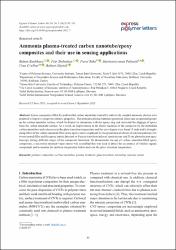Ammonia plasma-treated carbon nanotube/epoxy composites and their use in sensing applications

Göster/
Erişim
info:eu-repo/semantics/openAccessTarih
2022Yazar
Benlikaya, RuhanSlobodian, Petr
Riha, Pavel
Puliyalil, Harinarayanan
Cvelbar, Uros
Olejnik, Robert
Üst veri
Tüm öğe kaydını gösterÖzet
Epoxy composites filled by multiwalled carbon nanotubes treated by inductively coupled ammonia plasma were prepared to improve composite intrinsic properties. The ammonia plasma treatment generated amine and oxygenated groups on the carbon nanotube surface, which facilitated its interaction with the epoxy ring and restricted the slippage of epoxy from the carbon nanotube surface. As a result, an improvement in the elastic modulus of the composite by the embedded carbon nanotubes and a decrease in the glass transition temperature and the cure degree were found. It indicated a strengthening effect of the carbon nanotube filler in the epoxy matrix explained by the generation of chemical reaction pathways between treated filler and the epoxy matrix detected by Fourier transform infrared spectroscopy and X-ray photoelectron spectroscopy during different stages of the composite formation. To demonstrate the use of carbon nanotube-filled epoxy composites, a microstrip resonant vapor sensor was assembled that was used to detect the occurrence of volatile organic compounds and to monitor the ambient temperature below and over the glass transition temperature.

















